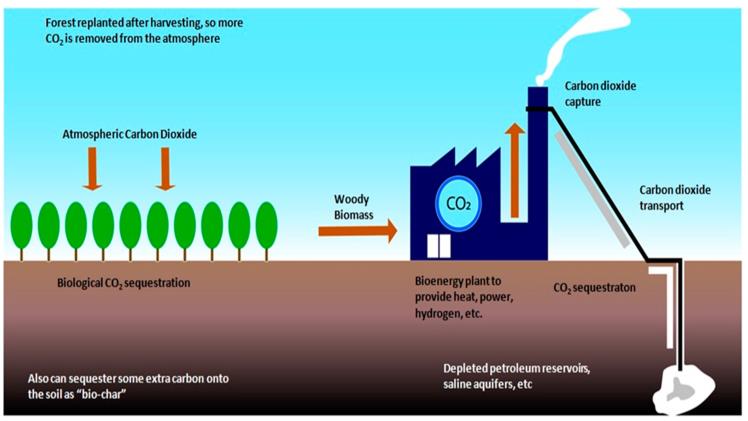As the world grapples with the ever-increasing threat of climate change, carbon capture and storage (CCS) has emerged as a pivotal technology for mitigating carbon dioxide (CO2) emissions. CCS involves capturing CO2 from industrial processes and power generation, transporting it, and storing it underground to prevent it from entering the atmosphere. Despite its potential, the widespread adoption of CCS is hindered by efficiency and cost challenges. Enhancing the efficiency of carbon capture is crucial for making this technology economically viable and environmentally impactful.
This article explores various strategies and solutions for improving carbon capture efficiency, ranging from technological advancements to policy and economic incentives.
Technological Advancements in Carbon Capture
Post-Combustion Capture
Post-combustion capture is a widely used method that involves capturing CO2 from flue gases emitted by power plants and industrial facilities. The process typically uses chemical solvents, such as amines, to absorb CO2. Enhancing the efficiency of post-combustion capture involves optimizing these solvents and improving the overall process. Researchers are also exploring new materials and technologies to increase carbon capture efficiency, which can lead to cost reductions and higher rates of CO2 removal. By focusing on improving carbon capture efficiency, we can make significant strides in reducing industrial emissions and combating climate change.
Advanced Solvents
- Amine Blends: Traditional amines, such as monoethanolamine (MEA), are effective but can degrade and consume significant energy during regeneration. Advanced amine blends, combining different amines, can offer improved absorption capacity, stability, and lower regeneration energy requirements.
- Ionic Liquids: These are salts that are liquid at room temperature and have shown promise in capturing CO2. Ionic liquids can absorb more CO2 per unit mass than conventional solvents and require less energy for regeneration.
- Solid Sorbents: Materials like metal-organic frameworks (MOFs) and zeolites are being explored for CO2 capture. These solid sorbents have high surface areas and can selectively capture CO2, potentially reducing energy consumption compared to liquid solvents.
Pre-Combustion Capture
Pre-combustion capture involves gasifying fossil fuels to produce a mixture of hydrogen and CO2, which is then separated. This method is commonly used in industries like natural gas processing.
Integrated Gasification Combined Cycle (IGCC)
IGCC technology integrates pre-combustion capture with power generation, using the separated hydrogen as a clean fuel. Enhancements in gasifier design, improved catalysts, and advanced membranes for gas separation can significantly boost the efficiency of IGCC systems.
Oxy-Fuel Combustion
Oxy-fuel combustion burns fossil fuels in pure oxygen instead of air, producing a flue gas that is primarily CO2 and water vapor. This simplifies CO2 capture.
Advanced Oxy-Fuel Systems
- Cryogenic Air Separation: Traditional methods of producing pure oxygen are energy-intensive. Cryogenic air separation technologies are being refined to reduce energy consumption and improve the efficiency of oxy-fuel combustion.
- Membrane-Based Separation: Using advanced membranes for oxygen separation can further enhance efficiency. Membrane technologies can operate at lower temperatures and pressures, reducing overall energy requirements.
Direct Air Capture (DAC)
DAC captures CO2 directly from the ambient air, offering the potential to reduce atmospheric CO2 levels irrespective of emission sources. While still in its early stages, advancements in DAC technology are critical for its scalability and efficiency.
Sorbent Development
- Metal-Organic Frameworks (MOFs): MOFs have a high affinity for CO2 and can be tailored for specific applications. They offer promising potential for DAC due to their tunable properties and high surface areas.
- Synthetic Sorbents: Researchers are developing synthetic sorbents that can efficiently capture CO2 at lower costs and with reduced energy requirements. Innovations in sorbent materials are crucial for making DAC commercially viable.
Process Optimization
Beyond improving capture materials and technologies, optimizing the overall process is essential for enhancing carbon capture efficiency.
Heat Integration
Carbon capture processes, particularly those using chemical solvents, are energy-intensive. Implementing heat integration strategies can significantly improve efficiency.
- Heat Recovery: Capturing and reusing waste heat from industrial processes can reduce the energy demand of carbon capture systems. Heat exchangers and advanced thermal management systems can facilitate effective heat recovery.
- Energy Storage: Integrating energy storage solutions, such as thermal energy storage, can help manage the intermittent energy demands of carbon capture processes, leading to more stable and efficient operations.
Process Intensification
Process intensification involves redesigning processes to achieve higher efficiencies and lower energy consumption.
- Modular Systems: Developing modular carbon capture units allows for more flexible deployment and easier scaling. Modular systems can be tailored to specific applications and integrated into existing industrial setups with minimal disruption.
- Hybrid Systems: Combining different capture technologies, such as integrating post-combustion and pre-combustion capture methods, can leverage the strengths of each approach and enhance overall efficiency.
Advanced Monitoring and Control
Implementing advanced monitoring and control systems can optimize the performance of carbon capture processes.
- Real-Time Monitoring: Using sensors and data analytics to monitor process parameters in real-time enables operators to make informed adjustments, improving efficiency and reducing downtime.
- Automation and AI: Incorporating automation and artificial intelligence (AI) can enhance process control, predict maintenance needs, and optimize capture conditions. AI algorithms can analyze large datasets to identify patterns and optimize system performance.
Future Prospects and Innovations
Advanced Materials
The development of advanced materials for CO2 capture is a promising area of research. Metal-organic frameworks (MOFs), ionic liquids, and solid sorbents offer significant improvements in capture efficiency and energy consumption. Continued research into these materials can unlock new possibilities for enhancing carbon capture processes.
Hybrid Systems
Hybrid systems that combine different capture technologies can leverage the strengths of each approach. For example, integrating post-combustion capture with direct air capture can maximize CO2 removal efficiency. Developing hybrid systems requires innovative engineering and design to seamlessly integrate multiple technologies.
Negative Emissions Technologies
Negative emissions technologies, such as bioenergy with carbon capture and storage (BECCS) and direct air capture (DAC), hold the potential to remove CO2 from the atmosphere. Scaling up these technologies is crucial for achieving net-zero emissions and addressing hard-to-decarbonize sectors. Investments in research, development, and deployment are essential for realizing the full potential of negative emissions technologies.
Digitalization and AI
The integration of digital technologies and artificial intelligence (AI) can revolutionize carbon capture processes. AI algorithms can optimize capture conditions, predict maintenance needs, and enhance process control. Digital twins—virtual replicas of physical systems—can simulate and optimize carbon capture operations, improving efficiency and reducing costs.
Conclusion
Enhancing carbon capture efficiency is critical for making CCS a viable solution for mitigating CO2 emissions and combating climate change. Technological advancements, process optimization, and supportive policy frameworks are essential for overcoming current challenges and unlocking the full potential of carbon capture. By investing in research, development, and deployment, we can drive innovation and scale up carbon capture technologies to achieve significant reductions in CO2 emissions. As we transition to a sustainable future, enhancing carbon capture efficiency will play a pivotal role in ensuring environmental sustainability and securing a livable planet for future generations.






